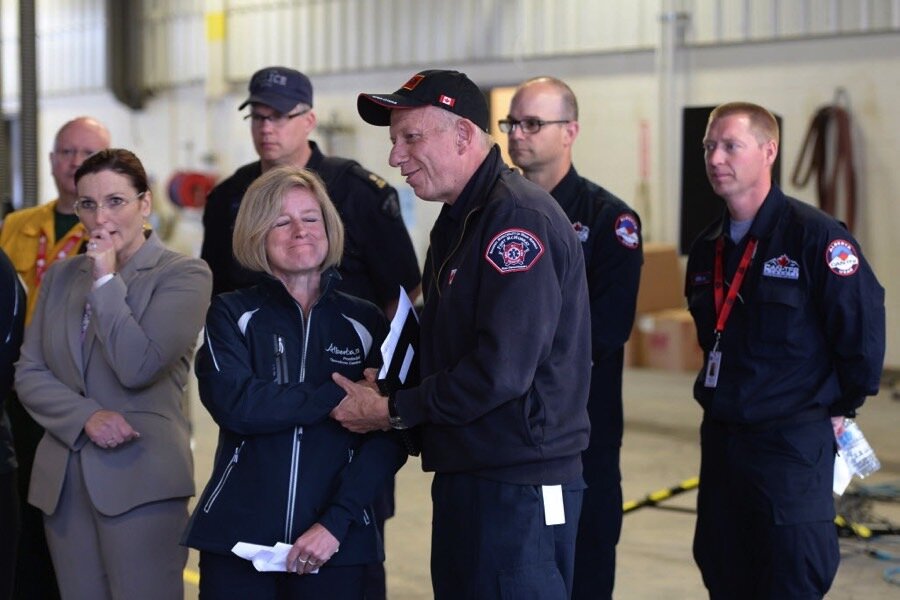Hope in Fort McMurray: Canadian officials find 90 percent of homes saved
Loading...
| FORT McMURRAY, ALBERTA, CANADA
Canadian officials who got their first glimpse on Monday of the oil sands boomtown of Fort McMurray since a wildfire erupted said they were encouraged by how much of it escaped destruction, estimating almost 90 percent of its buildings were saved.
But a tour of the fire-ravaged city also revealed scenes of utter devastation, with blocks of homes reduced to blackened foundations, front steps and metal barbecues.
Alberta Premier Rachel Notley said 2,400 structures had burned within the city while almost 25,000 were saved.
The fire that has ravaged some 204,000 hectares (504,000 acres) of the western Canadian province moved far enough from the evacuated town of 88,000 people to allow an official delegation led by the Notley to visit.
"We were really encouraged today to see the extent of residential communities that were saved," Notley said. "That of course doesn't mean there aren't going to be some really heartbreaking images for some people to see when they come back."
Reporters on the tour viewed the charred rubble of the community's Beacon Hill neighborhood, where some 80 percent of the homes had been burned to the ground and the wreckage of blackened and melted cars remained on roads.
Notley said it was not safe for residents to enter the city unescorted, with parts still smoldering and large areas without power, water and gas. She said repair crews will have weeks of work ahead of them.
Fire Chief Darby Allen told reporters that 85 percent of the buildings in Fort McMurray had survived the blaze, offering a slightly lower estimate than Notley. All schools except one that had been under construction were intact. Notley credited the efforts of firefighters who battled the out-of-control blaze for days.
The assessment by officials came a few hours after insurance experts revised sharply downward their estimates of the cost of damage from the blaze, which began on May 1.
Canada's largest property and casualty insurer Intact Financial Corp expects to suffer losses ranging from C$130 million to C$160 million ($100 million-$123 million) from the wildfire. Intact used satellite imagery and geocoding technology to see if buildings were a total loss or partially destroyed.
Analysts said Intact's forecast implied overall industry losses of between C$1 billion C$1.1 billion, much less than one earlier forecast of C$9 billion.
Prime Minister Justin Trudeau vowed a multi-year commitment by the national government to rebuild Fort McMurray but gave no details.
Fire officials said the blaze was still large, growing and dangerous. But they noted cooler weather had slowed the fire's spread and would help in the coming days. High temperatures and winds accelerated the blaze last week.
The cool weather was expected to linger through Thursday, according to Environment Canada. Still, much of Alberta is tinder-box dry after a mild winter and warm spring.
"This beast is so big, we need rain to fix it," Public Safety Minister Ralph Goodale said.
Government weather forecasts show the first possibility of rain on Wednesday with a 30 percent chance.
Notley said she expected to be able to provide a schedule within two weeks for the return of residents. Thousands of evacuees are camped in nearby towns.
Fort McMurray is the center of Canada's oil sands region. About half of its crude output, or 1 million barrels per day, has been taken offline, according to a Reuters estimate.
In one encouraging sign for industry, Royal Dutch Shell Plc said it restarted production at a reduced rate at its Albian oil sands mining operation in Alberta, and it plans to fly staff in and out.
But Statoil ASA said it will suspend all production at its Leismer oil sands project in northern Alberta until midstream terminals needed to transport crude oil via pipeline reopen.
And Imperial Oil said it completed a controlled shutdown of its Kearl oil sands mining project due to uncertainties associated with logistics.
Other shutdowns include Nexen Energy's Long Lake facility, Suncor Energy's base plant operations, a Syncrude project and Conoco Phillips' Surmont project.
Nearly all of Fort McMurray's residents escaped the fire safely, although two teenagers died in a car crash during the evacuation.
As The Christian Science Monitor reported on Monday, recovery in Fort McMurray has already become "a nationwide effort that has seen disparate communities – including Syrian refugees taken in by Canada; victims of 2013's rail disaster in Lac-Mégantic, Quebec; and even Canadians thousands of miles away who happen to have a spare room – rally together to help those languishing from an ongoing disaster that spanned 625 square miles on Sunday."
(With additional reporting by David Ljunggren in Ottawa, Nia Williams in Calgary and Matt Schuffman, Ethan Lou and Allison Martell in Toronto; Writing by Scott Malone and Jeffrey Hodgson; Editing by Jeffrey Benkoe and Cynthia Osterman)







